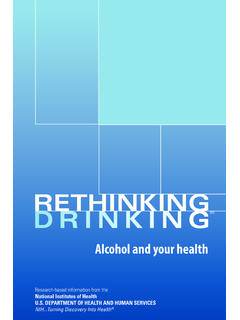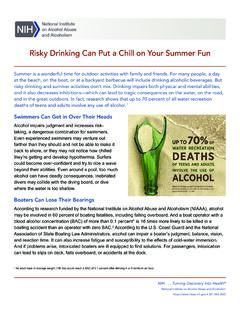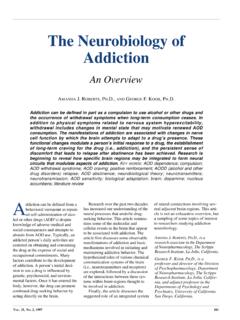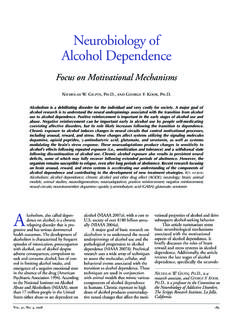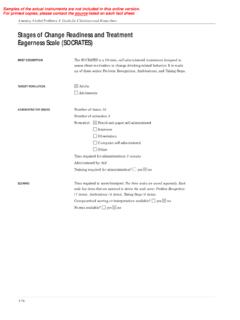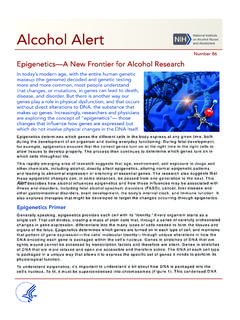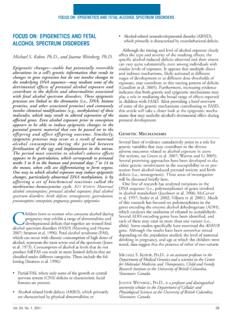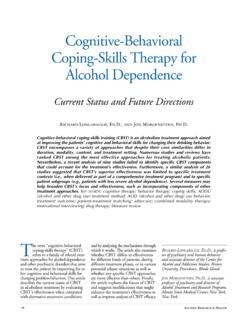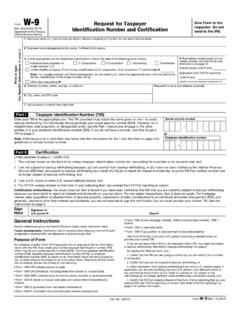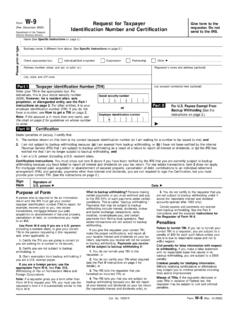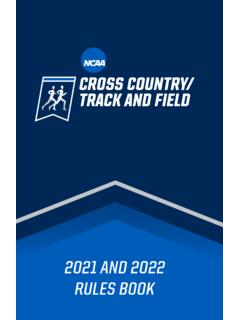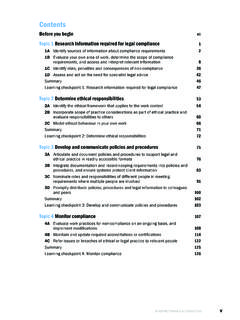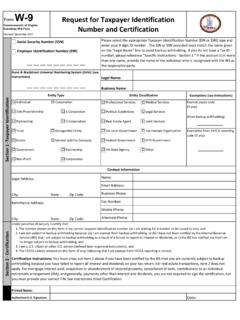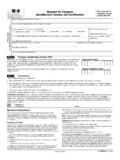Transcription of Alcohol and Violence - National Institutes of Health
1 54 Chapter 1: Drinking Over the Life Span: Issues of Biology,Behavior,and RiskOf the million victims of violent crime eachyear, almost one in four, or million, reportthat the offender had been drinking Alcohol priorto committing the crime (Greenfeld 1998).Among the attacks that were committed bycurrent or former intimate partners of the vic-tims, two out of three of the offenders had beendrinking prior to the attack (Greenfeld 1998).Over the years, consistent findings such as thesehave stimulated research into factors that mightcontribute to Alcohol -related Violence and thequestion of whether Alcohol use is not merelyassociated with, but perhaps a cause of, Violence is the result of complexinteractions between individual and environ-mental factors that either promote or inhibitviolence.
2 Findings from numerous studiesimplicate several variables including personalityfactors, individual expectancies, situationalelements, and sociocultural influences that may interact with Alcohol s pharmacologic is not clear is whether and under whatcircumstances these interactions may combine to lead to violent episodes. It is also not knownwhat interventions might prevent or reduce thelikelihood of Alcohol -related recent years, however, using increasinglysophisticated methodology, researchers have madeadvances in understanding the individual andenvironmental factors related to Alcohol andviolence and in addressing the issue of addition.
3 The field is progressing as a result of new theoretical frameworks that describe the complex interplay between individual andenvironmental influences and incorporate an interactional level that is influenced by section focuses on recent developments inthese at the individual level include investi-gations of Alcohol use by both the offender andthe victim. Regarding the offenders, research haslong indicated that there is an association betweendrinking and the perpetration of violent acts (forreviews see Collins 1981, 1989; Lipsey et ; Pernanen 1976, 1981, 1991; Roizen 1993,1997).
4 More recent research has extended thisfinding by examining related items of interestsuch as variations by the amount of Alcohol used, the severity of the ensuing injuries, and the social relationship between the offender and the the victims of Alcohol -linked Violence ,studies have investigated risk factors for becominga victim and have examined whether Alcohol con-sumption by the victims, as well as the offenders,might influence those risks. Although the studyof Alcohol use by victims is newer and somewhatless developed, it is proceeding along some of thesame avenues as research on offenders, such aslooking at the relationships between offenders and section also reviews studies about environ-mental factors in the relationship between alcoholand Violence .
5 These include studies of individualbars and street locations as well as studies ofcomparative crime rates across cities and key variable in this research is sometimesalcohol availability rather than Alcohol consump-tion. The expectation is that decreased availabil-ity might lead to decreased consumption, whichmight lead in turn to lower rates of is of interest because it is a potential policy lever that could be manipulated if acausal relationship between availability andviolence rates were firmly important goal of this research is to advancebeyond simply finding that Violence rates increasewith increasing Alcohol consumption, to movetoward scientific results that would strengthen our ability to conclude whether this relationshipis causal.
6 Two kinds of environmental or policy-based studies are useful steps in this direction: Alcohol and ViolenceAlcohol and Violence55those that gather data at set intervals over time,and those that gather data both across time and at different pursue across-time studies by collect-ing data in several waves over time (longitudinalsurvey studies) or by analyzing regularly collecteddata series, such as annual homicide rates forcities (time-series studies). These study designshelp to establish the temporal relationshipsbetween variables, an important step towarddemonstrating causality.
7 Even though, forexample, variables A and B might be related in the sense that whenever A happens, B alsohappens, A cannot be said to cause B unless Ahappens before B. Furthermore, when data arecollected regularly over time, studies can revealsuch associations as two variables rising andfalling in synchrony. Demonstration of this kindof relationship would provide more persuasiveevidence of an underlying causality than, forexample, the finding of a one-time connectionamong variables through a cross -sectional either case, however, an apparent relationshipbetween two variables may actually be caused by a third, unknown factor.
8 Thus, studies thatattempt to establish causality must not onlydetermine the timing of events, but also identifyand measure the effects of any intervening factorsthat may have affected the effective than the across-time approachalone is one that also gathers data from severaldifferent locations (across time and across space,or a pooled, cross -sectional, time-series analysis ).These designs give researchers a particularlystrong basis for attributing causality in the find-ings. Recent work on environmental contribu-tions to Violence has pursued both paths in orderto gain deeper insights into the question included in this section is a review of somerecent theoretical developments in the field ofalcohol and Violence .
9 In addition to advancesmade through research, the knowledge base inthis field can increase through the development ofnew conceptualizations to explain facts or emerging, these conceptualizations becomeshared among scientists and eventually are testedin studies. Thus, a look at the developingtheories is a preview of the kinds of empiricalstudies that are likely to be conducted , a few words on the scope of this , it does not address self-inflicted Violence (that is, suicide). Second, it focuses on epidemio-logic or population-based studies and thus omitsample research using laboratory animals (forreviews of this literature see Brain et al.)
10 1993;Higley and Linnoila 1997; Miczek et al. 1997;Yudko et al. 1997) and human laboratory experi-mental studies (for recent meta-analyses of thisliterature see Bushman 1997; Lipsey et al. 1997).These studies suggest that there is no simple orinevitable relationship between Alcohol andaggression. Psychopharmacologic, personality,cognitive, and situational factors all appear to playimportant roles in influencing whether violencewill occur. Nevertheless, experimental findingsdo suggest that, in laboratory settings, alcoholtends to increase aggressive responses in a waythat might be interpreted as relatively strongsupport for a causal effect of Alcohol consumptionon Studies:Drinking by OffendersThe National Crime Victimization Survey(NCVS) has found consistently that Alcohol ismore likely than other drugs to be involved insubstance-related Violence .
